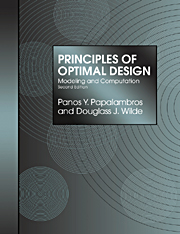1 - Optimization Models
Summary
For the goal is not the last, but the best.
Aristotle (Second Book of Physics) (384–322 b.c.)Designing is a complex human process that has resisted comprehensive description and understanding. All artifacts surrounding us are the results of designing. Creating these artifacts involves making a great many decisions, which suggests that designing can be viewed as a decision-making process. In the decision-making paradigm of the design process we examine the intended artifact in order to identify possible alternatives and select the most suitable one. An abstract description of the artifact using mathematical expressions of relevant natural laws, experience, and geometry is the mathematical model of the artifact. This mathematical model may contain many alternative designs, and so criteria for comparing these alternatives must be introduced in the model. Within the limitations of such a model, the best, or optimum, design can be identified with the aid of mathematical methods.
In this first chapter we define the design optimization problem and describe most of the properties and issues that occupy the rest of the book. We outline the limitations of our approach and caution that an “optimum” design should be perceived as such only within the scope of the mathematical model describing it and the inevitable subjective judgment of the modeler.
Mathematical Modeling
Although this book is concerned with design, almost all the concepts and results described can be generalized by replacing the word design by the word system.
- Type
- Chapter
- Information
- Principles of Optimal DesignModeling and Computation, pp. 1 - 43Publisher: Cambridge University PressPrint publication year: 2000
- 2
- Cited by

